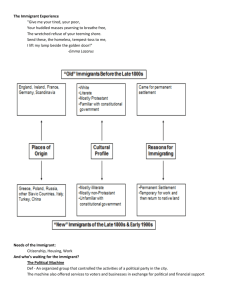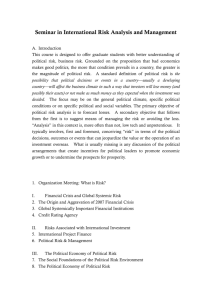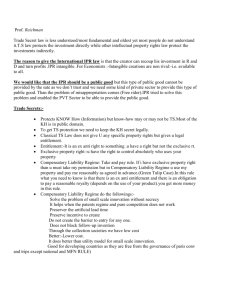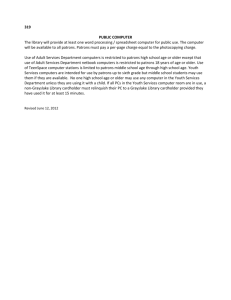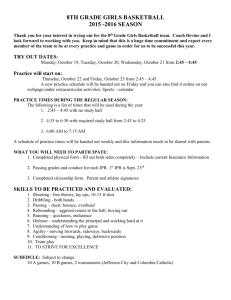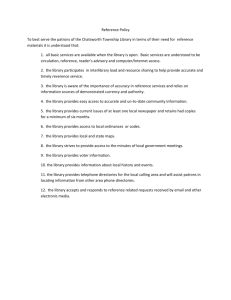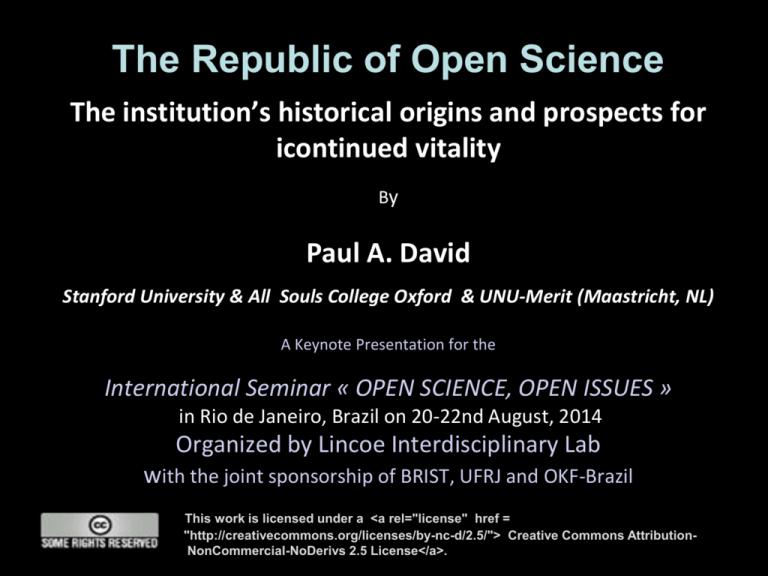
The Republic of Open Science
The institution’s historical origins and prospects for
icontinued vitality
By
Paul A. David
Stanford University & All Souls College Oxford & UNU-Merit (Maastricht, NL)
A Keynote Presentation for the
International Seminar « OPEN SCIENCE, OPEN ISSUES »
in Rio de Janeiro, Brazil on 20-22nd August, 2014
Organized by Lincoe Interdisciplinary Lab
with the joint sponsorship of BRIST, UFRJ and OKF-Brazil
This work is licensed under a <a rel="license" href =
"http://creativecommons.org/licenses/by-nc-d/2.5/"> Creative Commons AttributionNonCommercial-NoDerivs 2.5 License</a>.
The Menu
PROLOGUE : Motivation and Principal Messages
PART I :
Some economics of research activities
PART II :
Open science’s ethos and institutions
PART III:
The historical circumstances in which Open
Science first emerged
PART IV:
Modern challenges to the survival of Op Sci
and their legacy – the New Open Science
PART V:
A Cautiously Optimistic Conclusion
Prologue
Motivation and MessagesI
Background and Motivation
• critical importance of exploratory research for major
advances in scientific knowledge
• comparative efficiency in exploratory research of the fragile
complex of informal norms and institutionalized practices
associated with ‘open science’ (Op Sci)
• self-organized collective creativity has been as important in
•
the responses to modern external threats as in Op Sci’s
origins
universalist and collective pursuit of scientific knowledge,
self-organized by the respective research communities
resonates more with ethos of the early Renaissance’s
Republic of Letters than with metaphorical notion of “the
market for ideas” – leading economists’ analysis of the
institution to lag that by sociologists
Principal messages from the ‘new economics of science
about the the formal and informal institutions of the
Republic of ‘Open Science’
-1
OpSci belongs to a larger class of decentralized,
non-market systems of knowledge and information
production and distribution that are important,
intricate interesting, and only recently studied
systematically by economists.
OpSci is a comparatively efficient (but not perfect)
system of resource allocation for producing reliable
new knowledge, but it performs comparatively
poorly in capturing ‘social surpluses’ from the
exploitation of existing knowledge.
Principal messages about the Rep-OpSci
-2
OpSci therefore can interacts positively in many
ways with the proprietary R&D regime at the
macro-system level, sustaining rapid rates of
technological progress – when (and if) the two
complementary sub-systems are kept properly
“balanced.” To achieve and maintain that balance
is the central science and technology policy
challenge for modern economies.
OpSci, like other cooperative institutional
arrangements, is fragile and its performance (and
hence the overall research system’s performance)
can be seriously degraded if it is not protected
from market competition for resources.
Part I
Some modern economics of the
organization of research activities
● The peculiarity of information as an
economic good
● Three macro-institutional questions
about the existence of distinctive modes of
organizing research activities
Why do we have different institutions for organizing
research activity? The economist’s (‘ahistorical’) answer
for publicly funded open science goes as follows:
:
Information is the key input as well as the output
of research, and it has public good properties:
a) infinite expansibilty, i.e., negligible marginal
transfer costs and non-rival use
b) indivisibility (i.e., information is integral and
heterogenous) and it has substantial fixed costs of
creation
c) significant costs of effectively excluding access
to and assuring exclusive possession of such goods
Thomas Jefferson recognized the “public goods”
properties of ideas and information…in 1813:
"If nature has made any one thing less susceptible than all
others of exclusive property, it is the action of the thinking
power called an idea, which an individual may exclusively
possess as long as he keeps it to himself; but the moment
it is divulged, it forces itself into the possession of every
one, and the receiver cannot dispossess himself of it. Its
peculiar character, too, is that no one possesses the less,
because every other possesses the whole of it. He who
receives an idea from me, receives instruction himself
without lessening mine; as he who lights his taper at
mine, receives light without darkening me.
“That ideas should freely spread from one to another over
the globe, for the moral and mutual instruction of man, and
improvement of his condition, seems to have been
peculiarly and benevolently designed by nature, when she
made them, like fire, expansible over all space, without
lessening their density in any point, and like the air in which
we breathe, move, and have our physical being, incapable
of confinement or exclusive appropriation."
Economic implications of public goods for the
organization of scientific research activities:
Competitive markets fail to allocate ‘public
goods’ efficiently, due to
‘transactions externalities’ – try to sell a secret for
its full information value
possibilities for ‘free-riding’ – full demand isn’t
revealed
Competitive pricing (at incremental cost)
leaves most (fixed) costs uncovered, even at
large scale
external use benefits (from ‘spillovers’) not
properly valued by private willingness-to-pay
Classic economic analysis in “public finance”
identifies three solutions for the problem of
providing “public goods” (e.g., water and lighting
utilities)
tax-financed subsidies
monopoly
direct public provision.
Correspondingly, we identify:
“The 3 P’s” -- co-existing institutionalized solutions
for the problems posed by information-goods:
Patronage – and the ‘open science’ reward system
Property — IPR monopoly rights
Procurement -- public production and/or “sourcing”
“The Three P’s” and the Mix of Solutions
to the Information-Appropriation Problem
Intellectual Property Rights
Public
Provision
Private or Public
Patronage
Q 1: What is special about the open science
mode of organizing research that justifies it
being supported by (State or Private) patronage?
b7
The cooperative (open) mode is especially functional
– it promotes the rapid cumulative process of
advancing reliable knowledge :
A “collegiate reputational reward structure” (CRRS) provides incentives
and signals for agents’ effort allocation decisions
A researcher’s reputational standing is based on the peer community’s
acknowledgement of the validity of claims to “priority of discovery”
There is incentive compatibility between the priority rule and the norm of
open-ness (full disclosure) :
asymmetric information problems of input monitoring
monitoring of output, with rewards for priority rapid disclosure
Q 2: How do the “3 P’s” co-exist productively in
modern economies?
• Open Science, being non-proprietary and requiring the
support of Patronage is suited for maximizing the growth of
the stock of reliable knowledge
• Proprietary R&D is suited for maximizing the volume of
economic ‘rents’ extracted from the existing stock of
knowledge
• It is most efficient that some government mission
agencies conduct the research on which their action must
be based (e.g, public health actions; space research).
Q 3: Why can’t we combine the best of each
regime in just one set of institutions?
•This is what has been promoted by policy-makers seeking
to emulate the Bayh-Dole experiment and induce EU
universities to embark on producing and exploiting
intellectual property;
• But there is a conflict between that purpose and the
university’s performance of it main social role as host for
independent scientific inquiry and scholarly critique, and as
disseminator of reliable knowledge: organizations with
conflicting purposes are likely to serve both badly.
• University administrations could probably learn how to
exploit the IP produced by their faculty, but what would they
not being attending to whilst learning that skill.?
Part II
Open science’s ethos and institutions
“Open science”– understanding a remarkable
social innovation
What are the ethos, norms and institutions that
distinguish the “Republic of (Open) Science”?
Why do we have a number of quite different
“organizational regimes” for conducting scientific
research? Particularly, why have both ‘open science
and ‘propriety R&D’?
How could “open” science arise in a world of secret
knowledge, and the secretive hunt for “Nature’s
Secretes”?
Institutional features structure resource
allocation in ‘the Republic of Science’
The key institutionalized social ‘norms’ that R. K.
Merton (1973) identified are readily remembered
using J. Ziman’s (1994) mnemonic :
C ooperation
U niversalism
D isinterestedness
O pen-ness
S cepticism
Idealized social norms and institutionalized procedures
of modern “open science” (the Republic of Science)
Idealized social norms
• cooperation and trust among scientists
• autonomy in determination of research
agendas
• personal disinterestedness in research
outcomes
• full disclosure of findings and methods
• expectation of verification by replication
Idealized social norms and institutionalized procedures
of modern “open science” (the Republic of Science)
Stylized procedural arrangements
rewards based upon collegiate reputational status
reputation based on peer-appraisal of ‘scientific
contributions’
eligibility for evaluation based upon non-ascriptive
characteristics
substantial autonom of individual in design and
research conduct is expected (and with this goes
responsibliity for the research)
‘a scientific contribution’ requires validation of the
researcher’s claim to priority in discovery or invention
institutional features and resource allocation in
the Republic of Science
Functionality of the cooperative system that promotes rapid
cumulative growth in reliable knowledge:
“collegiate reputational reward structure” (CRRS) provides incentives
and signals for agents’ effort allocation decisions
scientific reputational standing is based on community
acknowledgement of claims to “priority of discovery”
incentive compatibility of priority with the norm of open-ness (full
disclosure) :
asymmetric information problems of input monitoring
monitoring of output, with rewards for priority rapid disclosure
disclosure, skepticism and disinterestedness validation of results
promotes rapid “closure” (effective consensus)
universalism prevents “homogenization” of social communications
network structure protecting deviant opinion from premature
formation of consensus (dogmatic belief)
The “Logical Origins” of Open-Science Institutions:
Functionalist Rationale
GOAL: Rapid Accumulation of Knowledge
Public Knowledge
Validation
Publication Procedures
Disclosure Norms
Priority Races
Reward System
OS is not a perfect institution: its key features
cause inefficiencies in research resource allocation
Priority-based rewards creates conflicts between incentives to compete
and the norms of cooperation and openness (typically resolved by dynamic
“switching”.
Although “peer-interest” affects expected size of “rewards” priority, this
also induced “herding”: excess concentration of effort on particular topics and
problems.
Tournament-like payoff structure induces inefficient (wasteful, excessively
duplicative) “racing” behavior.
Positive feedback from reputation effects on access to research inputs
leads to path dependence in career dynamics (the “Matthew Effect”),
degrading reliability of signals of ability in competition for new funding.
Public patronage means that societal needs must be translated into
government science policy by a political process, which creates more scope
for private political interests extraneous to both scientific or technological
merit to affect the allocation of funding for research.
Part III
The European circumstances in which the
ideas and practices of open science arose
● The medieval world of “hidden knowledge”
● The “Scientific Revolution” of the 17th century
●
Noble patrons and mathematicians
The historical origins of the Open science
Revolution… are not its ‘logical origins’:
‘Open science’ emerged in Europe during the latter 16th
and early 17th centuries, accompanying but distinct from
the epistemological transformation of the Scientific
Revolution.
The development of this mode of engaging in research -as a collective cooperative undertaking --constituted a
break from the older tradition of secretively pursuing
“Nature’s Secrets”….
….a socio-institutional development that owed more to
renaissance mathematics than to any imperatives of the
new mechanical philosophy and observational methods of
the Scientific Revolution.
The medieval world of arcana
-1
• The
moral obligation was to be circumspect
about revealing the “Secrets of Nature’ – an
old idea
•
•
Belief in the original wisdom or knowledge of
the ancients’ (prisca sapientia), imparted by
God to Adam, and lost to man, was common
among the learned in the middle ages
The pseudo-Aristotelian Kitab Sirr al Asrar,
translated as the Secretum secretorum (“The
Book of the Secret of Secrets”) was the most
popular, widely copied book of the middle ages
[Thorndike (1950: ii)]
The medieval world of arcana
•
-2
The historical continuity of the imperative of
secrecy among an elect few, for altruistic motives
–
Si haec scientia hominibus esset discoperta,
confunderent universum : “ If this knowledge was
revealed to all men, it would confound the universe”
– Cornelius Agrippa [1486-1532], German-born
philosopher-alchemist, emphasized the venerable
tradition of secret knowledge: Plato had forbade
disclosure of ‘the mysteries’, Pythagoras, and
Porphyry [232-305 c.e.] bound their disciples to
silence about their teachings
– Or, as Newton wrote in the 18th century, to
uncover
the secrets sought by the old Alchemists risked
bringing “immense dammage to ye world.”
The medieval world of arcana: ‘hidden knowledge’
Al khataab…secret secretorum: the most popular medieval
book
Craft-guild restrictions preserving the “mysterie of the
trade”—discouraged
working fine crafts in the open
Guild cartel practices’ indirect effects:
-- increased value of technical secrets reinforced balkanization of
information circulation
17th c. Maps showing trade routes were kept secret
The Alchemical tradition: the hunt for health, wealth and
power – is highly instrumental, valuable and dangerous; the
hunt it was to be pursued in closed “clubs” or “circles”.
SCHEMA OF THE 17TH C. EPISTEMOLOGICAL REVOLUTION:
“The Fusion of Mathematics and Experimentalism”
Astronomical
and
Astrological
‘Observational
Programs’
Tycho
Brahe
15461601
‘Experimentalist
Program’
Roger Bacon
c.1220-c.1292
Arabic
Mathematics
Introduced
In West
Nicholas Copernicus
1472-1543
Francis Bacon
1561-1672
‘The Scientific Revolution’
Galileo 1564-1642
Kepler 1571-1630
Descartes 1596-1650
Second Generation of Experimental and Mechanical
Natural Philosophers: Boyle, Newton, Hooke,
Huygens, Gilbert, Harvey, Torricelli, Pascal
‘Classical
Mathematics’
Aristotelian
‘Natural Philosophy’
Medieval
‘Occult
Science’
Renaissance Mathematics
(15th and 16th centuries)
Regiomontanus 1432-76
Tartaglia c. 1500-65
Cardano 1501-76
Galileo’s
Scholastic
Opponents
‘Chemical Alchemy’
And Occult Sciences
The medieval world of arcana--‘hidden knowledge’, 2
•
The medieval alchemical tradition had dual aspects
– Alchemy was regarded as a form of personal knowledge, a “divine
science, …a way of life of life, a great work which absorbed all mental and
material resources.” [B.Y.T. Dobbs,1975]
– The ‘hunt’ for health, wealth and power was also an instrumental search
for knowledge by experimental methods, its ‘quarry’ being viewed as
valuable to possess as they were dangerous to disclose to the multitudes
– The practice developed into the sophisticated mid-17th c. form of
“chemical alchemy”, carried by Boyle, Issac Newton and other ‘rational
scientist’--who participated in closed “circles”, within circulated special
materials and manuscripts phrased in ambiguous terms and obscure
notations
•
Craft-guild restrictions preserved the ‘mysteries of the
trade’, inhibiting generation and spread of new technology
-- e.g., by discouraging the working of ‘fine crafts in public view [Long, 1991]
-- urban guilds’ cartel practices had direct and indirect effects [Ogilvie, 2004]:
output restrictions increased the value of technical secrets
employer cartels reinforced balkanization of information circulation
If new practices of revealing Nature’s Secrets had
reflected just the effects of a purely intellectual, or
ideological shift, why wouldn’t the new idea of
‘public knowledge’ have triumphed completely?
Yet, the worlds of ‘hidden’ and ‘revealed’ research
co-existed during the early Scientific Revolution...
and well beyond it…
•
•
•
The leading scientific figure of the age, Issac Newton
continued his researches in chemical alchemy from 1660s
through 1690’s – filling notebooks with 1.2 mn. words on
the subject, more than all his other writings
London “projektors” in the mid 17th c. who dreamed up
new science-based business schemes kept them secret
…Puritan social reformers (in Saml. Hartlib’s circle)
dabbled in alchemy, especially magical medicinal recipes
Symbols from Newton’s ‘Liber Mercurioum Corporum’, the “Book of
the Mercuries of Bodies” -- one of his earliest alchemical manuscripts
(Keynes MS 31), dating from the late 1660’s
This table was prepared by Newton to explicate the symbols used in the recipes he copied
for extracting “mercuries”, most probably, according to Dobbs (1975), from manuscripts
collected by members of the Hartlib circle in London, who interested themselves in
chemical alchemy among other ‘practical projects’ in this period.
‘The Historical Origins’: overview of the thesis
Open Science Institutions
Communications
Technology
and Institutions
Intellectual
Authority
Conventions
Patronage
System
Conventions
‘Historical Origins’: details of the thesis
17th Century
Development of Open Science
Institutions and Norms
Publication as
Means of Disclosure
and Advertising
Copyright
Laws
Printing
Technology
Reputational
Tournament
Processes
Legitimization
Organizations
for Scientists
Intellectual
Authority
Problems
Principal
Agent
Problems
New
Mathematics
Patronage System
‘Ornamental
Motives’
New Experimentalism
Noble patrons, mathematicians, and
principal-agent problems
Multiple motivations for patronage
-- the utilitarian and the ornamental
Renaissance mathematicians’ successful
development of useful applications
-- also brought greater informational
asymmetries between client-savants and their
patrons, few of whom were mathematicians
The Ornamental Motivation of noble patrons in
Renaissance Europe was instrumental -- about
POWER AND THE MANIFESTATION OF MAGNIFICENCE:
Mary Hollingsworth (1995: p.1), writing of Renaissance patrons of art
and architecture, describes the usage of magnificence in state-craft:
"For them, art was the prime vehicle for the display of status,
ambitions, beliefs and achievements; it was not a statement of
their aesthetic sensibilities. The magnificent palaces and their
lavish decoration commissioned by governments, guilds and
individuals were designed to demonstrate the wealth and power
of their owners....They understood [architecture's] value as
propaganda. Pope Nicholas V insisted that magnificent buildings
were essential to convince ordinary people of the supreme
power of the Church. The Venetian government began to build a
costly clock tower at a time of economic instability to
demonstrate that the state was not bankrupt.”
RENAISSANCE MATHEMATICS -- A century after
Regiomontanus, the practical “fruits” of mathematics had
become a commonplace prescription for humanist
educational reform:
The Jesuit mathematician Christoph Clavius,] n 1586, prescribed the
identification of mathematical passages in Aristotle as pedagogical exercises
and stressed the centrality of mastering the mathematical disciplines for an
understanding of the new ‘mechanical philosophy’:
“Physics cannot be understood correctly with [the mathematical
disciplines], especially what pertains to that part concerning the number
and motion of the celestial orbs, of the multitude of intelligences, of the
effects of the stars…, of the divisions of continuous quantities to infinity,
of the tides, of the winds, of comets, the rainbow, haloes, and other
meterorological matters, or the proportion of motions, qualities, actions,
passions, reactions etc., concerning which the calculatores [of
fourteenth century-Merton College, Oxford] wrote much. I omit an infiinity
of examples in Aristotle, Plato, and their most illustrious interpreters
which can in no way be understood without some knowledge of the
mathematical sciences.”
Source: English translation by Peter Dear, in Mesenne and the Learning of the Schools, Ithaca and London:
Cornell University Press, 1988: p.45, from Christoph Clavius, “Modus quo disciplinae mathematicae in
scholis Societatis possent promoveri,” In Monumenta paedogagical Societatis Iesu quae primam Rationem
The utilitarian involvements of leading scientists from the
late 15th through the late 17th century – reflected extensive
engagement with the “mathematized” technological fields
Principal technological field
Number
Medicine & Pharmacology*
All Non-Medical Techs
Engineering
Military
Hydraulic
Cartography
Navigation
Other Technologies
None
TOTAL
267
245
101
51
50
92
47
5
118
630
% of All NonMedical Techs
% of All
Scientists
42
39
100
41
21
20
38
19
2
19
100
Source: Tabulation of the practical involvements in technology of
individuals listed in the Dictionary of Scientific Biography as having been
born between 1470 and 1680 – from Westfall (1993)
Open challenges, claims of discoveries and
methods builds on the tradition of public trials
of methods in Renaissance mathematics
An early 1529 book’s depiction of a contest between an algorist and an abacist
Noble patrons, mathematicians
and principal-agent issues:
Coping with informational asymmetries in the
patronage system
● Challenges and public contests from mid-16th c.
onwards, especially among mathematicians
--
reputational competition gives rise to increasingly frequent
priority disputes towards the end of 16th century
● A exceptional opportunity for ‘direct confirmation’-the telescope and Galileo: in the quest for fame and
patronage, ‘autoptic proferrence’ was more effective
than independent scientific corroboration
Noble patrons, mathematicians asymmetric information
and principal-agent issues
-2
The telescope and Galileo
-- c.July, 1609 Gallileo learns of (1608) Dutch low-power
telescope
-- late August, 1609 presents 12 x ’scope to Venetian
Senate big salary at Padua
-- March 1610 : having built c. 20x ‘scope to observe the moon
and planets, he publishes Siderius nuncius, presenting his discovery
of the moons of Jupiter as the “Medicean Stars”
-- April, 1610, goes to Florence to make sure that Cosimo II will
view his “Stars”
-- June 1610: made Chief Mathematician at Pisa, and
Philosopher to the Grand Duke, he begins building ornate
telescopes for the Duke to send to princes and cardinal
-- September- December, 1610 first independent
corroborations of Jupiter’s moons: from Santini (Venetian
merchant); from Kepler (given one of Gallileo’s ‘scopes for his
patron Rudolph II by from the Elector of Cologne; and in December
from Jesuits in the Collegio Romano
Patronage, competition, and common
agency: some economic implications
The nature of “common agency games and
the distribution of information rents
Economic analysis and the Court Patronage System:
Common agency contracting, with rivalrous principals
________________________________________________________
Structural conditions:
• Nobel patron derives ‘ornamental’ and ‘utilitarian’ benefits from
clients’ services
• Strong informational asymmetry between patron and matematicianclient
• Patronage contract typically has two-part structure: a fixed ‘retainer’
and a variable ‘gift-reciprocation’ component based on novelty,
uniqueness, and propitious circumstances of client’s performance
• Client-savant typically has multiple patrons, i.e., ‘common agency
contracting
• ‘Positional-goods’ nature of benefits received by the patron (owing to
importance of ‘ornamental’ value of the client) implied common
agency contracting in substitutes is a dominant situation
Economic Analysis and the Court Patronage System:
Common agency contracting --- continued
________________________________________________________
Principal implications:
• Nash equilibrium of the game among patrons for client’s attention yields
‘weak incentives’ contract-structures, because each patron is aware of
the possibilities that they might be cross-subsidizing rivals (see Avinash
Dixit 1996).
•
‘Weak incentives’ reinforces the client’s acceptance of multiple patronage
contracts in the equilbrium.
•
Common agency contracts in substitutes leave the client/agent with a
larger equilibrium share of the informational rents, compared to
situations where principal’s benefits are pure complements – e.g.,
knowledge-services with major ‘spill-overs’ (see Lars Stole 1990).
•
Fragmented political authority (many courts) and ‘ornamental’ motives of
rival patrons created terms of support more favorable to clientsavants than conditions of centralized patronage, or primacy of patrons’
interests in non-positional goods – knowledge with utilitarian spillover
effects.
Main conclusion from the story of the
‘origins’ of open science practices:
• A pre-capitalistic disposition to award court patronage
(to the savants and virtuosi) for the purpose of
enhancing the ruler’s political power by displaying of
‘magnificence’ came to confer value on those pursuing
mathematics and the mechanical philosophy in the late
16th and 17th centuries.
• Fragmented political authority, and the symbolic
competition among many courts within Europe (the
legacy of feudalism) meant that common agency
contracts tended to be particularly favorable to the
scientist-clients—because the services provided were
viewed by their multiple patrons largely as substitutes,
rather than as complements.
Open science: “European feudalism’s greatest gift
to modern capitalism”
•Renaissance statecraft established the practice of awarding court
patronage (to savants and virtuousi) for the purpose of enhancing
the ruler’s political power-- by displaying ‘magnificence’-- came to
confer value on those pursuing mathematics and the mechanical
philosophy in the late 16th and 17th centuries.
• The progress of mathematics and its practical applications, by
exacerbating the asymmetric information problems of patrons, and
hence of their client-scientists – creating incentives for the latter to
build an external, peer-based reputation by public demonstration of
their abilities.
• Fragmented political authority, and the symbolic competition
among many courts within Europe (the legacy of feudalism) meant
that ‘common agency contracts’ tended to be particularly favorable
to the scientist-clients —because the services provided were viewed
by their multiple patrons largely as substitutes, rather than as
complements.
Open science --“European feudalism’s greatest gift to
modern capitalism” -- is a fragile legacy
• That process of institutionalization was distinct from, yet
was driven by, and reinforced the epistemological
transformations that historians associate with the Scientific
Revolution.
• Open science has been able to find public patronage and
reproduce itself through the enculturation (socialization) of
young trainee researchers -- because it turned out to be
highly productive when coupled with a market-driven
proprietary R&D regime oriented to create new technologies.
• Yet its cooperative institutional arrangements are fragile,
and can be undermined when they have to compete for
resources with a market system, so open science exists in a
state of uneasy tension with the proprietary R&D regime.
Part IV
Modern challenges to the
survival Open Science and the
legacies -the New Op Sci Movement
The Present & Future of Open Science
The optimum is not clearly identified, but we can tell
when changes are pushing the system out of balance.
Property
Public
Provision
Patronage
Fiscal pressures to “privatization” government informaiton
production, reinforced by stronger and more comprehensive
IPR protections, and the disruptive effects of ICT innovation,
and contributing to a drift toward the “property” pole.
Property – successive expansion of the IPR regime
Reinforcement of international conventions by bilateral agreements
TRIPs Agreeement: ‘harmonized’ national IP treatment at developed
country levels; created obstacles to recourse to compulsory licensing
Extensions of the domain of patenting in the U.S.:
living organisms: Diamond v. Chakrabarty (1980)
software : Diamond v. Diehr (1981)
business models: State Street Decision (2000).
Sui generis protections:
copyrights in semi-conductor mask work (1980)
EC directive on the legal protection of databases (1996)
ICT advances as drivers of IPR regime changes:
“self-help” technologies (water-marking, encryption, trusted
systems: foreclosure of effective “fair use” exclusions)
legal restraints on decryption of material that is protected by
copyright law: U.S. DMCA (1998); EU InfoSoc Directive (2002)
public domain
Intellectual property
rights
Some unintended consequences of stronger IPR
protections on public sector research results:
“Anti-commons” effects: patent thickets and royaltystacking raise barriers to exploratory, high risk research
Database linkage impeded by imposition of “passthrough” licensing conditions, and legal protection of
(non-compatible) digital rights management systems
PROs emphasis on obtaining and exploiting IPR
weakens norms of trust and cooperation among
researchers
IPR distribution conflicts complicates negotiations
between developed and developing country research
institutions, blocking some projects in extreme cases
(e.g., the U.C. Davis and the abandonment of the Andean
strawberry project)
digital technology and modern IP legislation
…may combine to end effective “fair use” limits
on monopolization of information-goods
DMCA and EU criminal law sanctions against decryption
sui generis legal protection of databases
digital rights management technologies & trusted systems
Together these have the potential to displace the copyright
regime as socially designed to balance private property rights
against protection of the public domain in data and information.
The result could be a regime of exploitation based upon indefinite
possession, greatly attenuated ‘fair use’, one-way private
contracting, and impediments to virtual federation of distributed
database contents.
Implying -- unintended ‘collateral damage’ to the ability of eResearch to fully exploit emerging collaboration technologies.
An historical irony: the digital technology
boomerang comes back...
…and hits ‘open science’
+
“Open science” research
_
Fundamental ICT
innovations
+
+
Disruption of industry
incumbents’ equilibrium
+
“Privatization”
of scientific data
and information
+
+
Proprietary R&D and
commercial innovation
+
IPR regime
revisions
+
Other public policy
drivers of privatization
+
+
+
Altered university-industry
research relationships and
technology licensing
+
Intellectual Property Rights and the Open
Pursuit of Knowledge: critical issues for
contemporary science and technology policy
How long can the Republic of Science survive in a
digital information technology environment organized
under a regime of “Intellectual Capitalism” ?
If open science is seriously curtailed by the
erosion of the public information domain that facilitates
low transaction cost access to data and research
findings, what does that mean for the sustainability of
long-run technological change at the pace experienced
in the past century?
….critical issues for contemporary science and
technology policy -- continued
If patronage support for open science shrinks,
relative to private industry support for
commercially oriented proprietary research,
what answers society’s need for independent,
disinterested scientific expertise?
If public research organizations conduct
scientific research to further their mission,
where is the “check” on the basis for public
action?
What could be done?
Two approaches to protecting OpSci
“Top down” responses – requiring political
mobilization for external legislative and legal
correctives
Statutory reforms in the IPR regime to restore
public domain conditions for publicly funded
researchers
“Bottom up” initiatives –
Organizing OA journals, repositories
Creating research commons by contract,
using IPR licensing powers
The response from academic science
communities – stimulated by “open source”
“Bottom up” initiatives to contractually construct
“research research resource commons” -- by licensing
intellectual property on terms that protect common-use
rights in information and data:
Working exemplars exist in the copyright domain:
Open access publishing of scientific preprints, and selfarchived pdfs of published articles – resisting the on-going
scientific publishers’ attack on the NIH’s ‘OA repository rule’
for its funded publications.
The Creative Commons (“some rights reserved” )
approach to licensing of scholarly and creative cultural
information products (text, images, sound): offering a menu
of standard licenses– http://creativecommongs.org
INITIATIVES TO DEFEND THE ‘OPEN SCIENCE WAY OF WORKING’
The 1990s saw the emergence of “bottom up” movement from
within academic research communities undertook to protect and preserve
shared and timely access to information and data resources, and to create
supportive tools, infrastructures and proceedures facilitating development of
sustainably available digital information resources.
These have included institutionally hosted repositories for scientific
pre-prints, journal articles and educational materials, “open access”
electronic journals published with the support of universities and not-for-profit
scientific organizations, public-domain digital data archives and federated
open data networks – for example:
U.S. open data centers and archives: GenBank, the Protein Data Bank, Space
science data centers;
Federated open data networks: World Data Centers, Global Biodiversity
Information Facility,NASA Distributed Active Archive Centers;
Publicly supported non-subscription and non-profit open access (OA) journals:
BioMed Central, Public Library of Science (PLOS), +and 65% of the c. 2500 nominally
“open access” scholarly journals);
Open institutional repositories for publications in a major subject areas:
PubMedCentral, arXiv.org (physics) e-Print Archive.
PROTECTING ACCESS TO DATABASE RESOURCES IN GENETICS
AND GENOMICS – USING CONTACTS: The “HapMap” paradigm:
HapMap is an example of an open collaborative research project whose
members created a sustainable public domain-like database resource that has
been protected against privatizatio by legally enforceable contracts.
The National Human Genome Research Institute (NHGRI) and other national
funding agencies launched the International Halotype Mapping Project in 2002
(see http://www.genome.gov/10001688).
HapMap’s Scientific Purpose
The haplotype map, or "HapMap," exemplifies a database tool that has been created to
allow researchers to find genes and genetic variations that affect health and disease.
The DNA sequence of any two people is 99.9 percent identical, but the variations may
greatly affect an individual's disease risk. Sites in the DNA sequence where individuals
differ at a single DNA base are called single nucleotide polymorphisms (SNPs). Sets of
nearby SNPs on the same chromosome are inherited in blocks, and the pattern of SNPs
on a block is called a haplotype. Blocks may contain a large number of SNPs, yet a few
SNPs are sufficient to uniquely identify the haplotypes in a block. The HapMap is a map
of these haplotype blocks; “tag SNPs” are specific SNPs that identify the haplotypes.
By reducing number of SNPs required to examine the entire genome for association with
a phenotype--from the 10 million SNPs that exist to roughly 500,000 tag SNPs–HapMap
provides a means of greatly reduce the costs and effectiveness of research in the field of
genetic medicine. By dispensing with the need to type more SNPs than the necessary
“tag SNPs”, it aims to increase the efficiency and comprehensiveness of genome scan
approaches to finding regions with genes that affect diseases.
Protecting future open access to critical data
is sometimes possible for a community that
is responsible for generating the data and able
to act ex ante – i.e., before their data is taken
into the regime of legal IPR protection:
A combination of technological “self-help” and
contract law can be sufficient to do that, as was
shown by the HapMap community….
Contractual construction of a research
commons within the sphere of IPR protection is
therefore an ex post “corrective” strategy .
The HapMap Project’s novel anti-privatization tool:
The HapMap Project followed the precedents established by the Human
Genome Project (HGP), by rejecting protection of the data under
copyright or database rights, and establishing a policy requiring
participants to release individual geneotype data to all the project
members as soon as it was identified.
It was recognized that any of the teams with access to the database
might be able to take that data and, by combining it with their own
genotype data, generate sufficient information to file a patent on
haplotypes whose phenotypic association with disease made them of
medical interest.
To prevent this, a temporary “click-wrap license” was created – the IHMP
Public Access License – which does not assert copyright on the
underlying data, but requires all who accessed the project database to
agree not to file patents where they had relied in part on HapMap data.
This is a “click-wrap” contract!
The IHMP-PAL is another special form of legal jujitsu, by which “copyleft” is mutually imposed on database users through an enforceable
contract, here in the absence of IPR ownership. Technological protection
of the database at a level sufficient to compel users to take the “clickwrap” license makes it possible to dispense with the legal protection of
asserting copyright in order to use “copyleft” licenses.
The contractually constructed quasi-commons
(or “club commons) is the immediately feasible
remedy for the anti-commons
-- and also for other less serious barriers to collaborative
production of information and data resources:
– It makes use of the legal protection afforded by the IPR
regime,and its limitations on total and indefinite monopoly
ownership;
-- It utilizes contract law to enforce compliance with voluntarity
entered agreements to pool IPR under common use or other
cross-licensing and “sharing” arrangments among members of t
he commons.)
public domain
research
commons
Intellectual property
Creating a “research commons” --by licensing intellectual
property to provide common-use rights has a number of
working precedents:
Open access publishing of scientific preprints, and selfarchived pdfs of published articles
The Creative Commons (“some rights reserved” )
approach to licensing of scholarly and creative cultural
information products (text, images, sound): offering a menu
of standard licenses– http://creativecommongs.org
Free/Libre and Open Source Software approach ensures
access to software tools by unconventional use of copyright
licensing terms: GNU GPL (‘copyleft’ principle) requires
distributors of code to do so on the same, open source,
royalty free, attribution basis on which they received the
code.
Ex Post Organization of Scientific Research Commons
… Biomedical Paradigms
Case 1:Creative Commons’ Neurocommons Project
http://sciencecommons.org/projects/data/background-briefing/
The NeuroCommons is a proving ground for the ideas behind Science Commons’ Data Project.
It is built on the legal opportunities created by Open Access to the scientific literature and the
technical capabilities of the Semantic Web.
EXECUTIVE SUMMARY
The Neurocommons project, a collaboration between Science Commons and
the Teranode Corporation, is building on Open Access scientific knowledge to
build a Semantic Web for neuroscience research. The project has three distinct
goals:
To demonstrate that scientific impact is directly related to the freedom to legally
reuse and technically transform scientific information – that Open Access is an
essential foundation for innovation.
To establish a framework that increases the impact of investment in neuroscience
research in a public and clearly measurable manner.
To develop an open community of neuroscientists, funders of neuroscience
research, technologists, physicians, and patients to extend the Neurocommons work
in an open, collaborative, distributed manner.
Case 2: Sage BIONETWORKS’ Drug Discovery Commons
.
SELECTIVE IMPLEMENTATION OF CONTRACTUALLY
CONSTRUCTED COMMONS IN INTANGIBLE AND NONEXHAUSTIBLE RESOURCES: EFFICIENT IPR POOLS
The case for efficient patent pools [see Shapiro, 2000;Lerner and
Tirole, 2002]; rests on overcoming the obstacles to research and
innovation posed by the growth of “ thickets” and designed
complementarities in claims that create blocking patents.
Defense against anti-trust objections to pooling would be easier
where there an empirical procedure for establishing the likelihood
that an inefficient patent cluster, i.e., a “thicket” had formed.
Clarkson (2005) proposes and demonstrates an application of
network analysis of patent citations to discover patent “thickets”
where complementarities lead to frequent “co-citation”.
Dual pricing policies by foundations running public PRC-i’s, are
potentially subject to abuse, and competition among the foundations
will be limited if complementaries are to be internalized. So anti-trust
supervision will be necessary here .
As the threat to the “open-ness” of open science system
posed by the expansion and strengthing of IPR protection
passed and the OA movement became established – with
all its problems that call for remedies….
There has emerged movement to renew Open Science
by transforming the production of scientific research and
the distribution of its findings in ways that would both
address long-recognized inefficiencies in Op Sci as a
resource allocation system, and the respects in which
communities of researchers in science remain
hierarchically structured.
This welcome development continues to display the
mixture of creativity, ingenuity and volunteered dedication
in “tool-building,” including organizational innovations -on the part of people within the academically based open
science communities, traits that served well its defense.
Beyond “defensive” measures – can the Open Science system
be thoroughly re-engineered to make it ”better” and less fragile?
Visions of a future mode of doing science are inspiring and energizing
pratical tool-building activities that are visible now on thousands of
pages of the Web .
E.g., Daniel Mietchen’s …
Open source software has provided a metaphor for the possible
emergence of a radically different and more effective model of
producing useful knowledge…in the form of algorithms, and tools that
permit fundamental restructuring of such work. But metaphors harbor
dangers along with their ability to liberate thinking. There are serious
problems in taking a metaphor to be a useful paradigm: the brilliant
success of open source was grounded on features of software and the
system within which its productions could readily be embedded. Code
is self-validating: it compiles and runs, or the doesn’t, it admits of
modularizations and semi-decomposability of its architecture – which
opens the way for its production to be distributed and to scale…
Beyond “defensive” measures – can the Open Science system
be thoroughly re-engineered to make it ”better” and less fragile?
contd
Science conducted in the traditional open science mode is not like
open source software development because it is not like software:
software code is self-validating, but scientific findings relate to
particular properties of large and complex natural systems, and their
implications and interpretation often remain contextually determined
and problematic.
As John Wilbanks (2009) pointed out, open source software’s success
stemed because the environment in which it arose facilitated its
development (and debugging) being distributed process. EXPAND
(see “modern science’ for Wilbanks).
To avoid the dangers of embracing and commitment resources to
forcing an inappropriate paradigm upon open science in the effort to
“improve it”, it is important not only to understand how Open Source
arose, but also to understand the open science system that we were
fortunate to have inherited, to grasp the sources of its comparative
efficiencies and their connect with the systems imperfections.
Tools for Open Science – an OKFN OP SCI Working Group Selection
http://science.okfn.org/tools-for-open-science/
In this page are listed a series of tools and services scientists can use to open their science.
These are organized in different topics covering different facets of Open Science. Some of these
tools are only targeted to certain fields of science, some are more general. Early 2013, the open
science community is very active. New initiatives emerge every week and it is hard to be up to
date. At the end of the page are links to other webpages tracking the creation and evolution of
tools with different emphasis.
Share Your Data – share data with other scientists of your field
Site
About
figshare Publish all of your research outputs in seconds in an easily citable, sharable and
discoverable manner. All file formats can be published, including videos and datasets
that are often demoted to the supplemental materials section in current
publishing models. figshare uses creative commons licensing to allow frictionless
sharing of research data whilst allowing users to maintain their ownership.
Collaborate & Reproduce Previous Studies--Transparently document and archive studies with
version control
Site
About
Open Science
-
The Open Science Framework (OSF) is part network of research
materials, Framework part version control system, and part collaboration
software. The purpose of the software is to support the scientist’s workflow
and help increase the alignment between scientific values and scientific
practices. The Reproducibility Project uses this system.
Toward the more radical “opening of Science”: OPEN NOTEBOOK Tools
notebooks.
Part V
A Cautiously Optimistic Conclusion
A cautiously optimistic conclusion 1
The main lessons and implications for the future
vitality of open science institutions that can be drawn
from an understanding of their origins, and the
experiences of the past 15 years, is that research
communities of this kind possess not only the
technical and organizational ingenuity, but also the
organizational capabilities to apply them to sustain
key features of their distinctive “way of working.”
Society at large has benefited from this, since it
served to protect the comparative efficiency if open
science’s collaborative modes of conducting socially
valuable exploratory, fundamental research.
A cautiously optimistic conclusion - 2
Moreover, researchers working in the open science mode
have demonstrated their ability to generate attractive projects
and proposals to radically restructure the way that science will
be conducted in the future, so that it can more fully exploit the
powers of digital information and computer-mediated
telecommunications networks.
For these efforts to succeed will require that they also work to
mobilize sustained adequate support from external, public and
charitable sources of funding, and “top down” public policy and
regulatory actions that will reinforce their informal norms. In
the way OpSci communities will be able to reproduce its ethos
in successive generations of university-trained researcher.
researchers.

